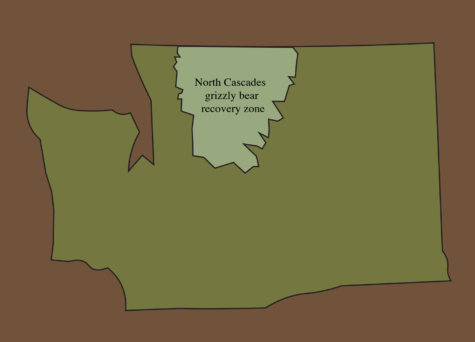The bears could be back in town
Alissa Lau (she/they)
The struggling grizzly bear population could benefit from reintroduction to the cascades.
January 23, 2023
On Nov. 10, the National Park Service and the U.S. Fish and Wildlife Service reintroduced a proposal to return grizzly bears to the North Cascades National Park. The proposal announced that, starting in 2024, three to seven grizzly bears will be brought to the North Cascades over the span of five to 10 years as an experimental population, with the goal of growing to a small population of 25 bears. The potential reintroduction of grizzly bears would allow biologists to observe them in their habitat and decide what adjustments might be necessary to ensure the population survives.
Overhunting and habitat loss has gradually deteriorated the national grizzly population, which is why they’ve been endangered in Washington State since 1980. According to the National Park Service, the North Cascades National Park has been declared as a suitable area to support grizzly bear populations since 1991. However, grizzly bears haven’t been seen in the North Cascades National Park since 1996.
Planning for restoration efforts began in 2014, but faced multiple halts during the Trump administration due to suspensions from former Secretary of Interior Ryan Zinke, who oversaw the conservation of land. Now, the process is beginning again with the proposal that was released on Nov. 10, which is currently going through multiple phases, including processing public input and drafting, before the project will begin.
The first wave of bears to be reintroduced to the North Cascades will be from northwest Montana or interior British Columbia, and will likely be between two and a half to six years old.
“The science shows that the best way to recover grizzly bears is to move mostly young females — subadults that haven’t yet had cubs — because once they have cubs, they don’t want to leave their home area,” said Joe Scott (he/him), the grizzly bear program leader and international programs director at Conservation Northwest.

The reintroduced bears will be monitored through radio telemetry collars. These collars, which can last up to two years, track each grizzly bear, allowing biologists to monitor their health.
“[The collars] also give a mortality signal, so if a bear dies, that collar will signal a biologist that the bear’s not moving,” said Scott.
Remote sensing cameras will also be placed in bear-heavy areas, sending alerts and photos to biologists when grizzly bears pass through.
“Bears have a kind of a circuit [where] they’ll travel around their home range looking for foods on a seasonal basis,” said Scott. “In the springtime, when they come out of their dens, there’s a lot of snow in a high country, so they have to feed on vegetation that’s lower down, like in the valleys, for example.”
The population will ideally grow to 200 bears 60-100 years after the first round of bears are reintroduced, which will be around 25 in size. Hopefully, the number will remain stable enough for the species to be removed as a threatened species from the ESA.
Although the reintroduction of grizzly bears to North Cascades National Park could pose danger to humans, these bears are an important part of the ecosystem. Grizzly bears enhance biodiversity by spreading seeds with their scat and aerating soil. Grizzly bears also keep small animal populations in control.
In addition to the important role they play in the environment, grizzly bears hold an important cultural role to local Indigenous communities. Scott Schuyler (he/him), the Cultural and Natural Resources Policy representative for the Upper Skagit Indian Tribe, described the community’s goal to restore and protect the animals and the ecosystem of the area.
“Our history here extends back to nearly 10,000 years and before contact, of course. We would like to see the grizzly bears and other species that have been removed returned back to the ecosystem,” said Schuyler.
Regardless of the benefits bears may have to the environment, local Indigenous tribes farmers and ranchers have expressed concern over keeping their crops and livestock safe from bears traveling outside of park boundaries. These concerns come despite the fact that the small population of bears likely will have little effect on farmlands, as 90% of the grizzly diet consists of berries and insects.
The safety of national park visitors is another potential concern. Park visitors will need to practice increased bear safety and be educated on bear-human interactions before spending extended periods of time in parks.
“We have all the tools to coexist with these animals if we do things correctly, if we’re aware of them, and they’re aware of us, and we behave appropriately, they’ll tolerate us and try and stay away from us. They generally don’t want anything to do with people,” said Scott.
Grizzly bears are an integral part of the North Cascade ecosystem that have been missing for too long. Restoration efforts are generally met with a positive response from the public, with many people in support of the reintroduction of the species.
“Most people are very, very supportive because people love these animals they want to see. Even with some fear or trepidation they have around running into a bear, they generally think these animals are pretty cool,” said Scott. “[They’re] beautiful, charismatic, powerful creatures, and there aren’t many places in the U.S. that can still support a viable population of grizzly bears. We’re fortunate enough to be one of those.”
This story was originally published on Nordic News on December 19, 2022.















![Finishing her night out after attending a local concert, senior Grace Sauers smiles at the camera. She recently started a business, PrettySick, that takes photos as well as sells merch at local concert venues. Next year, she will attend Columbia Chicago College majoring in Graphic Design. “There's such a good communal scene because there [are] great venues in Austin,” Sauers said. “I'm gonna miss it in Austin, but I do know Chicago is good, it's not like I'm going to the middle of nowhere. I just have to find my footing again.” Photo Courtesy of Grace Sauers.](https://bestofsno.com/wp-content/uploads/2025/05/Grace.png)




















